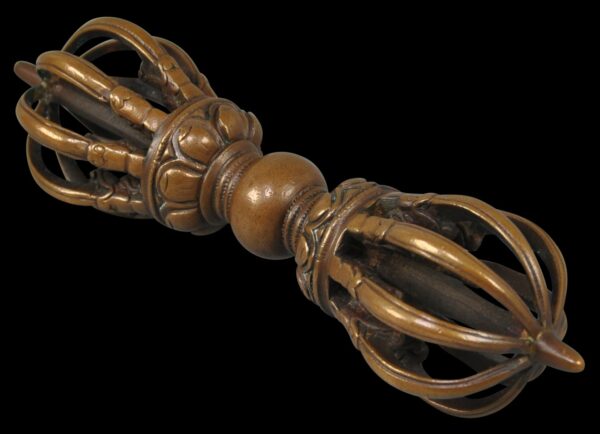Enquiry about object: 9438
Fine, Tibetan Nine-Pronged Vajra
Tibet 14th century
length: 16.7cm, width: 4.2cm, weight: 271g
Provenance
UK art market
The vajra (or dorje, ‘thunderbolt’) has a central spherical grip bordered on each side by fine beaded rings and then lotus petal borders. And then on each end, eight rounded prongs emerge from makara mouths around a central prong, making nine prongs altogether. (Vajras with five prongs are the more common type.)
The vajra is an important symbol in Mahayana Buddhism. Originally, the thunderbolt was a weapon of Indra from Indian Hindu legend. Indra became incorporated into Tibetan Buddhist lore as a disciple of the Buddha, and was transformed into the bodhisattva Vajrapani. The vajra emerged as the strongest weapon in the universe and became a symbol of the universal compassion of enlightened beings.
Iconographically, vajras with five prongs at one end are said to represent the five transcendent buddhas. The five prongs at the other end represent the five female buddhas. But vajra’s with nine prongs such as the example here are said to represent the five transcendent Buddhas, plus the four mothers or consorts of the four cardinal Buddhas namely Lochana, Mamaki, Pandara and Tara. The nine also are said to represent the profound nine vehicles of the Vajrayana.
See lot 117, Christie’s New York, ‘The Doris Wiener Collection’, March 20, 2012 for a related example also attributed to the 14th century.
The example here has smoothed contours from age and ritual handling. It has a beautiful brown patina.
References
Beer, R., The Encyclopedia of Tibetan Symbols and Motifs, Serindia, 2004.
Thurman, R.A. & D. Weldon, Sacred Symbols: The Ritual Art of Tibet, Sotheby’s/Rossi & Rossi,1999.










